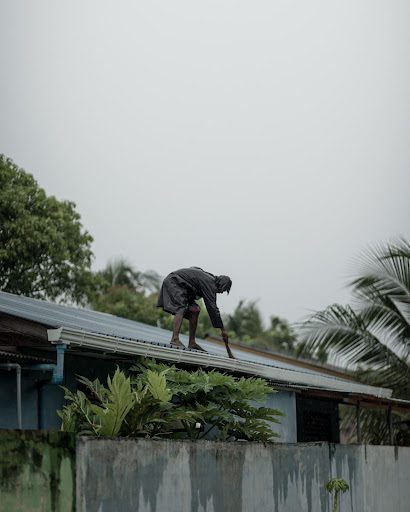Today, a guest post from Kathleen Anne Joven Nialla from Mighty Dog Roofing. As a homeowner, you can prevent damage to your roof, do some work yourself, and leave some repairs for the professionals. Here’s how to tell the difference:
One of the components of a house that is absolutely necessary is the roof. It protects the structure from the outside elements and contributes to keeping the interior of your home secure, dry, and comfortable. However, it is also one of the elements of the house susceptible to damage as a result of harsh weather conditions such as high winds, significant snow or ice accumulations, hail, and other natural disasters.
As a result, it is absolutely necessary to take measures to prevent damage to your roof during each and every season. The following are some suggestions on how to go about doing that.

Photo by Scott Webb on Unsplash
#1. Inspect Your Roof Regularly
Due to the harsh weather that often comes with each season, the first thing that you can do in protecting your roof is inspect it for signs of damage. You can do the inspection twice a year, in spring and fall, but the perfect season is before winter.
What to do:
During your roof inspection, look for any cracks, missing or broken shingles, and deteriorated flashing. These damages will lead to water leaks and cause more severe roofing problems if no action is taken.
You should also look out for any moss or mold on the roof. This is caused by moisture buildup, and it’s usually a sign that something is wrong with your roof.
Another thing to watch out for when inspecting your roof is tree limbs and debris. Any branches growing close to the roof can cause damage and potential blockages in your gutters or downspouts. If you notice any of these, contact a professional roofer immediately to assess the situation and take necessary action.
#2. Repair and Replace Damaged Areas
Once you’ve identified the damages, the next step that you can do in protecting your roof is to repair or replace them. Repairing or replacing a roof will take time, so it’s essential to start the process as soon as possible. Depending on the extent of the damage, you might need to hire a professional roofer to do the job, or you can just do it yourself.
What to do:
If your roof only has minor damages, such as loose shingles or cracked tiles, you can repair them yourself. Use roofing cement to secure the shingles or tiles and make sure any other surfaces are properly sealed. With the right tools and materials, you can easily fix the problem and ensure that your roof is in top condition.
If the damage is more extensive, such as large cracks or missing shingles, it’s best to hire a professional roofer such as Mighty Dog Roofing. They’ll be able to assess the damage and repair it using their expert knowledge and resources. Protecting your roof against damage won’t be a big hassle with their help.
#3. Clean your Roof Regularly
Like any part of your home, dirt, debris, and dust will eventually accumulate on your roof. This can cause damage to the shingles or tiles, leading to more severe issues such as leaks and other structural problems. In order to prevent these from happening, it’s essential to clean your roof regularly.
What to do:
To effectively clean your roof, use a power washer or pressure washer. This will ensure that all dirt, debris, and dust are removed. You should also use an appropriate cleaning solution. A mild detergent or bleach-based cleaner is usually enough to eliminate stains and dirt. If you have a metal roof, you should use a metal cleaner to ensure the surface is adequately protected.
However, if you find cleaning your roof difficult, it is best to contact a professional roofer. You mustn’t attempt to clean the roof yourself if you are unfamiliar with the process to avoid any damage and accidents.
#4. Make Sure Your Gutters Are Clear
Your gutters are essential in preventing water buildup on your roof. Buildup usually happens when leaves, twigs, and other debris accumulates in the gutters and clogs them. This will prevent water from flowing properly and cause water to pool on your roof, leading to potential damage.
What to do:
Regularly check if your gutters and downspouts are free of debris, every season. They are usually pretty clogged during the fall due to the leaves, so it’s important to check them often. You can use a garden hose or pressure washer to clean them and ensure the water flows freely. You should also install gutter guards to keep out leaves and other debris.
If you notice that your gutters are beyond repair or in bad shape, it’s best to replace them with new ones. This will go a long way toward protecting your roof from water damage and other potential issues.


Leave A Comment